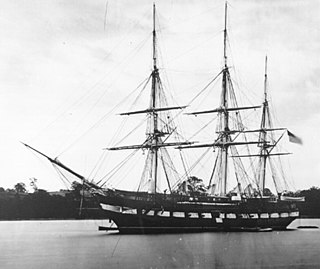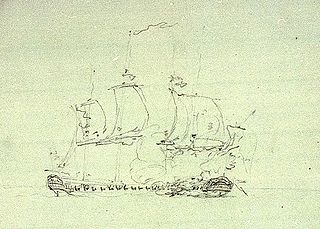Seven ships of the Royal Navy have been named HMS Nymphe, HMS Nymph or HMS Nymphen after the Nymphs of Greek Mythology. Another was planned but never completed:

The Royal Navy (RN) is the United Kingdom's naval warfare force. Although warships were used by the English kings from the early medieval period, the first major maritime engagements were fought in the Hundred Years War against the Kingdom of France. The modern Royal Navy traces its origins to the early 16th century; the oldest of the UK's armed services, it is known as the Senior Service.

A nymph in Greek mythology is a supernatural being associated with many other minor female deities that are often associated with the air, seas or water, or particular locations or landforms. Different from Greek goddesses, nymphs are more generally regarded as divine spirits who animate or maintain Nature for the environments where they live, and are usually depicted as beautiful, young graceful maidens. They are often divided into various broad subgroups, such as Aurai (winds), Hesperides, Nereides (seas), Naiades and Dryades
- HMS Nymph was a 14-gun sloop launched in 1778 and burnt by accident in 1783.
- HMS Nymphe (1780) was a 36-gun fifth rate captured from the French in 1780 and wrecked in 1810.
- HMS Nymphen (1807) was a 36-gun fifth rate captured from the Danes in 1807. She was to have been renamed HMS Determinee, but this did not happen; she was sold in 1816.
- HMS Nymphe (1812) was a 38-gun fifth rate, built as HMS Neriede but renamed in 1811 and launched in 1812. She was placed on harbour service from 1836, renamed HMS Handy in 1871, and was broken up in 1875.
- HMS Nymphe (1866) was a wooden screw sloop launched in 1866 and sold in 1884.
- HMS Nymphe (1888) was a composite screw sloop launched in 1888. She became a base ship and was renamed HMS Wildfire in 1906, and HMS Gannet in 1916 and finally HMS Pembroke in 1917. She was sold in 1920.
- HMS Nymphe (1911) was an Acorn-class destroyer launched in 1911 and sold in 1921.
- HMS Nymphe was to have been a modified Black Swan-class sloop laid down in 1945 but cancelled later that year.
HMS Nymph was a 14-gun Swan-class sloop of the Royal Navy launched at Chatham Dockyard on 27 May 1778. She was accidentally burnt and sank in the British Virgin Islands in 1783.

In the 18th century and most of the 19th, a sloop-of-war in the Royal Navy was a warship with a single gun deck that carried up to eighteen guns. The rating system covered all vessels with 20 guns and above; thus, the term sloop-of-war encompassed all the unrated combat vessels, including the very small gun-brigs and cutters. In technical terms, even the more specialised bomb vessels and fireships were classed as sloops-of-war, and in practice these were employed in the sloop role when not carrying out their specialized functions.

HMS Nymphe was a fifth-rate frigate of the British Royal Navy, formerly the French La Nymphe. HMS Flora, under the command of Captain William Peere Williams, captured Nymphe off Ushant on 10 August 1780. Indiscriminately referred to as Nymph, Nymphe, La Nymph or La Nymphe in contemporary sources, she served during the American, French Revolutionary and Napoleonic Wars. On 19 May 1793, while under the command of Captain Edward Pellew, she captured the frigate Cléopâtre, the first French warship captured in a single-ship action of the war. After a long period of service in which she took part in several notable actions and made many captures, Nymphe was wrecked off the coast of Scotland on 18 December 1810.

